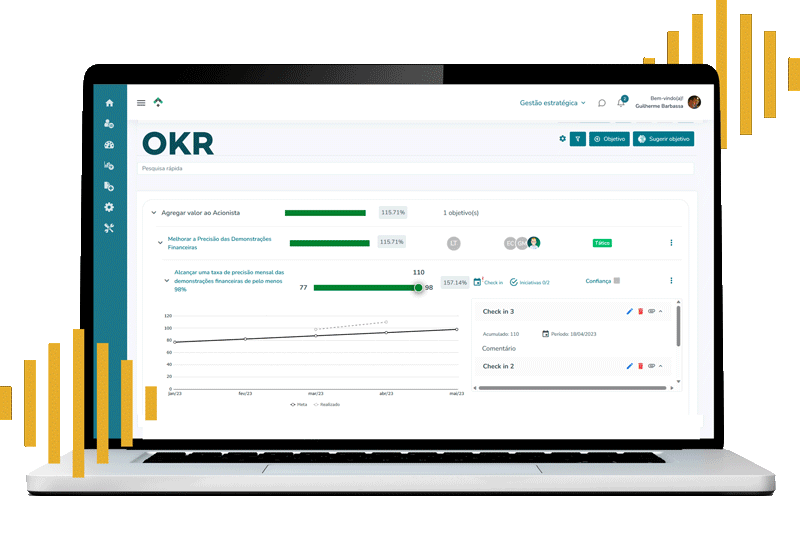Today’s corporate environment is more dynamic than ever, and companies that manage to align purpose, performance, and strategic agility are one step ahead. In 2025, OKRs are once again at the forefront of discussions on governance, innovation, and sustainable productivity. But how can this methodology be applied to generate real impact? Find out here.
Enjoy the read!
What you will find on this blog:
ToggleWhat Are OKRs – and Why They’re Back in Focus in 2025
OKR stands for “Objectives and Key Results,” a management methodology created by Andy Grove at Intel and popularized by John Doerr at Google. Unlike rigid, traditional goal-setting models, OKRs offer an agile and transparent framework to align inspiring objectives with measurable results..
More than just a planning tool, OKRs have become a driver of organizational culture and strategic engagement. In 2025, with the rise of generative AI, ESG priorities, and decentralized work structures, the need for clear, focused, and coherent goals has become even more critical.
According to a 2025 FGV report, 64% of companies that implemented OKRs with continuous review reported increased decision-making agility and a 21% reduction in costly rework.

The Challenges of the New Scenario: Speed, Transparency, and Impact
Today’s context requires leaders to align performance with purpose — and do it fast. With growing pressures around governance, compliance, and sustainability, defining “what matters” and “how we know we’ve achieved it” has become vital. Companies now face:
- Hybrid and globally distributed teams;
- The need for data-based decision-making in shorter cycles;
- Demand for innovation without losing predictability or control.
In this scenario, OKRs stand out by promoting focus without micromanagement, accountability without overload, and innovation with alignment.
“Effective OKRs connect daily actions with the impact an organization wants to make in the world.”
- Harvard Business Review
How to apply OKRs effectively: a guide to 2025
Adopting OKRs isn’t just about filling out quarterly spreadsheets. It’s about understanding a strategic construction process:
1. Define 3 to 5 Objectives per Cycle
- They should be clear, ambitious, and aligned with organizational strategy.
- Example: “Strengthen leadership in sustainable solutions in sector X.
2. Associate 2 to 4 Measurable Key Results
- They must objectively indicate success, with clear metrics.
- Example: “Reduce carbon emissions by 15% by September” or “Reach an NPS of 80 among ESG clients.”
3. Promote Short Cycles and Ongoing Reviews
- The quarterly cycle remains the most common, but mature companies already operate with monthly micro-cycles for verification and adjustment.
4. Use Integrated Tracking Tools
- Ferramentas e soluções integradas, como Actio Gestão Estratégica e Power BI permitem visualização em tempo real e alertas automáticos de desalinhamento.
Common Mistakes – and How to Avoid Them
Even experienced, performance-driven organizations can fall into traps that compromise OKR effectiveness. A recurring error is setting vague or generic objectives like “improve results” or “increase engagement,” which lack clarity and direction.

Another common misstep is imposing top-down goals without active listening or team involvement, which undermines ownership and execution. A more subtle risk is confusing outcomes with deliverables — prioritizing tasks over measurable impact.
Avoiding these pitfalls requires an ongoing process of organizational learning. The path includes cultivating leadership that guides without micromanaging, nurturing a culture focused on meaningful outcomes, and creating consistent spaces for feedback and strategic dialogue. Training, review cycles, and support tools are essential allies in this journey.
The Future of OKRs: ESG, AI, and Meaningful Outcomes
The new wave of OKRs is emerging as a strategic tool to address the challenges of a transforming corporate landscape. Key trends include the adoption of internal public OKRs, fostering transparency and shared accountability across teams and leadership.
Another frontier is the integration of AI for predictive analytics — capable of identifying patterns of misalignment or underperformance before they impact results. Furthermore, linking OKRs to ESG metrics helps bridge operational goals with long-term social and environmental responsibilities.
These practices not only strengthen organizational coherence but also enhance market trust. A 2025 study by PwC Brasil revealed that organizations aligning OKRs with ESG targets outperformed by 18% in stakeholder trust indexes, reinforcing OKRs as a bridge between strategy, culture, and impact.
A vantagem de usar Actio Gestão Estratégica na gestão de OKRs
To apply these trends effectively and consistently, organizations need platforms that integrate technology, data intelligence, and strategic focus.
That’s where Actio Strategy Management shines as one of the most robust OKR management solutions in 2025. Designed for dynamic organizational environments, Tune delivers customizable dashboards, smart alerts, ,, o Actio Gestão Estratégica oferece recursos como painéis personalizáveis, alertas inteligentes, relatórios preditivos e visualizações intuitivas de alinhamento entre áreas. Além disso, oferece um mar de outras metodologias para melhor servir o seu negócio. Elas podem, inclusive, ser integradas para otimizar ainda mais visualização e escolhar assertivas.

Além disso, o Actio Gestão Estratégica permite incorporar OKRs a contextos desde responsabilidade corporativa (compliancecompliance, ESG, and governance — as well as operational layers. This provides a solid foundation for data-informed, agile decisions. Teams can track progress in real time, detect misalignments early, and adjust paths with confidence and autonomy.
Ao empoderar líderes e colaboradores com informações relevantes e acionáveis, o Actio Gestão Estratégica transforma a gestão por OKRs em uma prática contínua de evolução e impacto — exatamente o que empresas precisam para prosperar em 2025.
Follow us on our socials — LinkedIn, Instagram and Facebookfor practical, insightful tips for your corporate journey.







